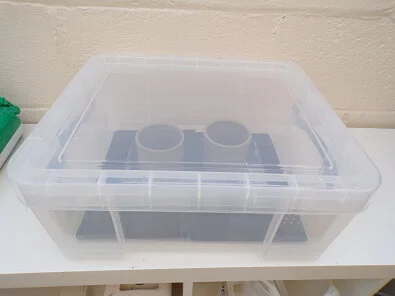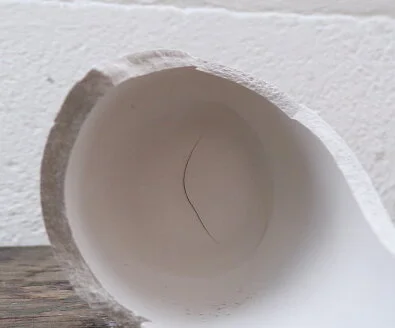Why do pots crack?
And how Potters can prevent cracking in their pots.
A lot of emphasis is placed on the making process in pottery but the drying process is equally important. Drying is often the time when stresses in work start to show and by the time a pot is dry, any cracks that have appeared are difficult to fix. Here are five reasons why cracking may occur and how to prevent it.
1. ) Clay is drying out too fast
If one part of a pot dries out much faster than another, stresses are placed on the pot and cracking can occur. This is particularly the case for attachments such as handles or if a rim is much thinner than the pot body.
Prevention: potters can make a homemade ‘damp-box’ to dry work slowly and evenly. By storing work in a plastic storage box with a lid it prevents work from drying too quickly. Work will still dry in the box but at a much slower rate. I use an 18 litre ‘really useful storage box’ from Argos which was £10.
2.) Joining clays of different dryness
If clays of different dryness are joined, they will often crack apart. This can occur if a handle is added to a cup that is too dry, or the handle itself is too dry.
Prevention: both pieces should be at the same stage of drying for the join to work. If cracking does occur potters can try using vinegar and a paintbrush to smooth the crack. Vinegar disintegrates clay and can be used to fix broken pots at the ‘greenware’ stage (when they are completely dry).
3.) Slip casting with a slip recipe low in ball clay
In the book ‘The Essential Guide to Mold Making & Slip Casting’ Andrew Martin explains that cracking in slip cast pottery can be due to low levels of ball clay in the slip recipe. Recipes high in ball clay produce pots that are strong and can withstand handling at the greenware stage.
Prevention: reducing the levels of china clay and increasing the ball clay content in the recipe will add strength and help prevent cracks from occurring. Andrew Martin’s book also contains some tried and tested slip casting recipes.
4.) Pot is too thick
If a pot is very thick it will often crack during drying because the surface layer of clay is drying faster than the layers of clay inside.
Prevention: wrapping work in plastic or using a damp-box can help it to dry slowly and evenly. Making work that is thinner and of an even thickness also helps.
5.) Extremes of temperature
Even when drying work in a homemade damp-box I have still had pots crack when the box got too hot. This is particularly the case in the summer when direct sunlight and summer heat accelerates the drying speed of pots.
Prevention: potters can place the damp-box in a temperate area, out of direct sunlight, to encourage slow and even drying.
Learn more
The ebook ‘Eco-Friendly Pottery: 30 Simple Ways: to make your pottery practice more ethical and sustainable’ from Oxford Clay, contains an eco-friendly stoneware casting slip recipe made with paperclay to prevent cracking.



